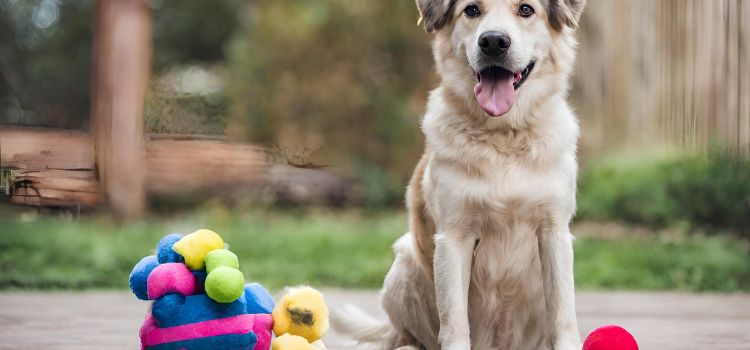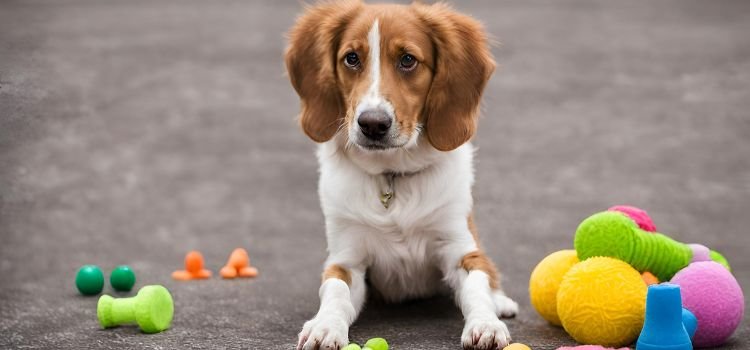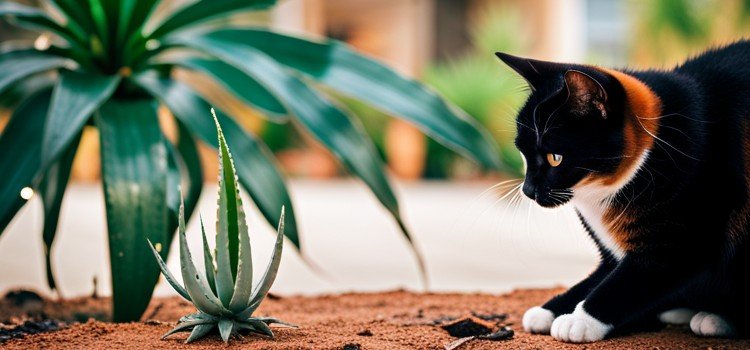As an Amazon Associate committed to the mission of improving the lives of our readers, Live-Clear.com receives a small commission from eligible purchases made through our affiliate links. This revenue enables us to keep producing insightful articles and other material.
Dogs play keep away to show dominance or to initiate playtime with their owners. This behavior is a natural instinct for dogs and is fueled by their innate need to hunt and chase prey.
Canine behaviorists suggest that playing keep away can also be a way for dogs to feel a sense of power and control over their environment. Playing keep away can be an enjoyable experience for both dogs and their owners. However, it is important to understand the motivation behind this behavior to ensure that it does not escalate into something more serious.

We will explore the reasons why dogs play keep away, how you can encourage or discourage this behavior, and what to do if your dog becomes aggressive during playtime. By understanding your dog’s needs and instincts, you can build a stronger bond with them and provide them with the appropriate outlets for their energy and playfulness.
The Importance Of Playing For Dogs
Dogs play keep away because it’s a way for them to satisfy their natural instincts, exercise, and improve their cognitive skills. Playing is essential for dogs as it provides physical and mental stimulation, helps them build social skills, and strengthens the bond between dogs and their humans.
As a responsible pet owner, you want to ensure that your furry companion is happy and healthy. One way to achieve this is to make sure they get enough playtime each day. Playing is not just something fun for dogs – it is essential for their physical and mental health. In this blog post, we will discuss why dogs play keep away and the importance of playing for your furry friend’s well-being.
Stress Relief
Just like humans, dogs can experience stress. Playing is an excellent stress reliever for dogs, and it can help reduce anxiety and tension. When dogs play, their bodies release endorphins, which are natural chemicals that promote feelings of pleasure and happiness. Playing also allows dogs to burn off excess energy, which can lead to a more relaxed and calm state of mind.
Social Interaction
Dogs are social animals and enjoy interacting with their humans and other dogs. Playing is an opportunity for dogs to communicate and bond with their owners and other dogs. Dogs who don’t get enough social interaction can develop behavioral problems such as aggression, anxiety, and depression. By playing with your furry friend, you are giving them a chance to socialize and have fun, which can lead to a happier and healthier life.
Playing is an essential activity for dogs, providing them with many benefits, including stress relief, social interaction, and overall well-being. As a responsible pet owner, make sure to dedicate enough playtime each day to keep your furry companion happy, healthy, and entertained.
Defining Keep Away
Dogs love to play games and one of their favorites is “keep away.” This game can be played with toys, balls, or even treats. Dogs enjoy playing keep away as it triggers their natural hunting instincts and provides them with mental and physical stimulation.
What Is Keep Away?
Keep away is a game where one dog has an item (toy, ball, etc.), and the other dog tries to get it. The dog with the item attempts to keep it away from the other dog. Essentially, the game is a version of catch where the goal is not to retrieve the object but to prevent the other dog from getting it.
Types Of Keep Away
Dogs play keep away in many different ways, with various objects and different playing dynamics. Here are some of the most typical types:
| Type | Description |
|---|---|
| Object Keep Away | This type of keep away involves an object like a stick, ball, or a toy. The dog with the item tries to keep it away from all other dogs. |
| Human Keep Away | Human keep away is when a dog takes an object and runs around the people, keeping it away from them. This type of game is popular among puppies but is played by adult dogs too. |
| Chasing Keep Away | In this type of keep away, one dog chases another dog to take an item (object or toy). The dog with the item must avoid being caught or touched by the other dog. |
Keep away is a fun game for dogs but can get too competitive or dangerous if unsupervised. It is always best to ensure a safe play environment and set clear rules and cues for the dogs while playing keep away. Understanding the different types of keep away can help dog owners and enthusiasts to engage and entertain their pets better.

Reasons Dogs Play Keep Away
Dogs have a natural tendency to play, which most dog owners would agree is adorable to watch. However, some dogs tend to play keep away, which can be frustrating for owners. Understanding why dogs play keep away can help owners cater to their dog’s needs and prevent any negative behavior that might stem from it.
Instinctual Behavior
Dogs have innate instincts that drive their behavior. One such instinct is the prey drive, which is a need to chase and capture prey. When a dog plays keep away, it can be an extension of this natural behavior. The dog may be engaging in a game of chase where it seeks to keep the object away from its owner, fulfilling a primal need.
Attention Seeking
Dogs are social animals and require attention. When dogs play keep away, they may be looking for their owner to chase them, creating a fun game that keeps the dog engaged and happy. This behavior is a way of seeking attention from their owners and keeping themselves entertained.
Dominance Assertion
In some instances, dogs may play keep away to assert their dominance. This behavior is often observed in situations where the object is seen as a valued resource, such as a toy or a treat. It’s a way for the dog to establish their ownership and dominance over the resource. This behavior is more common in dogs with strong personalities or those who have not received proper training.
The Science Behind Keep Away
Dogs play keep away as a natural instinct, rooted in their ancestors’ hunting behavior. They see objects as prey and enjoy the chase, making it difficult for others to obtain the item. Additionally, playing keep away serves as a source of entertainment and exercise for our furry friends.
Dogs love to play, and one of their favorite pastimes is “keep away.” You may have noticed that when you toss a toy or ball for your furry friend, instead of returning it to you, he may run away with it, tempting you to chase him. Dogs have an innate urge to play keep away, and there are several reasons why this is the case. In this post, we’ll delve into the science behind this playful behavior.
Neurological Effects
Playing fetch with your dog stimulates his natural hunting instincts, and it satisfies his need for mental stimulation and exercise. When your pup chases after a tossed toy, it activates the pleasure centers in his brain, releasing dopamine and other “feel-good” chemicals. These chemicals create feelings of excitement, and satisfaction which encourage your dog to keep playing. The more excitement your pooch feels, the more likely he is to run away with the toy and play keep away.
Environmental Factors
Sometimes, environmental factors can also contribute to why dogs play keep away. For example, if your pup grew up in an environment where there was competition for resources like food, toys, or attention, he may be more likely to play keep away. By keeping the toy or object away from other dogs or people, he’s protecting his valuable resource. In addition to this, if your dog has been trained to retrieve and hold onto objects, he may be more likely to play keep away because he’s trying to follow his training.
Playing keep away is a natural part of your dog’s behavior, rooted in his innate instincts and environmental factors. Understanding the science behind this behavior can help you create better play experiences with your pup, and help you to understand his actions better. Next time you are playing fetch with your furry friend, don’t be surprised if he decides to play keep away for a while. Just enjoy the moment and have fun interacting with your furry friend!

How To Manage Keep Away Behavior
When it comes to playing with dogs, it’s not uncommon to experience the delightful yet frustrating game of keep away. This behavior occurs when a dog takes an item, such as a toy or a sock, and runs with it in an attempt to keep it away from their owner. Although it may seem harmless and playful, keep away behavior can quickly turn problematic and lead to destructive chewing, resource guarding, and aggression. Luckily, you can manage and redirect this behavior through positive reinforcement training, redirecting behavior, and playing together.
Positive Reinforcement Training
Positive reinforcement training is a method of encouraging desired behavior through rewards. To encourage your dog to bring toys to you instead of running away, start by offering a high-value treat every time they bring a toy to you. Gradually, start to associate a command, such as “come” or “bring it,” with the behavior. As your dog starts to associate the command with the reward, you can increase the difficulty level by hiding the toy and encouraging them to find and bring it back. Keep repeating this process to build a solid foundation of this good behavior.
Redirecting Behavior
One way to redirect your dog’s keep away behavior is by substituting the item they have with another toy. When your dog is running away with an item, show them another toy and ask them to swap it for the item they have in their mouth. As you continue to reinforce the behavior of swapping toys, you can gradually start to add the command “swap it” or “let go” to create a positive association with this action.
Playing Together
Playing together with your dog can be an effective way to manage keep away behavior. When you play together, it becomes easier for your dog to trust you and less probable that they’ll run away with the toys. Pick a favorite toy and play with it in close proximity to your dog. Over time, gradually move away from your dog as they grow more comfortable and confident with playing with you. By playing together, your dog becomes more interested in socializing with you and less likely to want to grab items and run away.
Common Mistakes To Avoid When Dealing With Keep Away
Dogs playing keep away can be both fun and frustrating for owners. However, it is important to avoid certain mistakes such as chasing after your pet, yelling or punishing them, or using physical force. Instead, try redirecting their attention with toys or treats and reinforcing good behavior.
Punishment
One of the most common mistakes dog owners make when dealing with keep away is using punishment as a solution. It is crucial to understand that punishment never works in the long run. When dogs engage in keep away, they are often just playing and having fun. If you punish them for playing, they can interpret your behavior as negative, leading to fear, anxiety, and, in some cases, aggression. Therefore, it is essential to use positive reinforcement methods to encourage desirable behaviors.
Inconsistency
Consistency is key when dealing with keep-away. Dogs are creatures of habit, and they thrive in predictable environments where they know what to expect. Inconsistency in your behavior can confuse your dog and make it harder for them to understand what is expected of them. Always reinforce positive behaviors and avoid rewarding negative ones. Be consistent in your training schedule and set clear boundaries that make it easier for the dog to understand the acceptable behaviors.
Summary
In conclusion, keep away is common among dogs, and it takes time and patience to address. Avoiding the common mistakes of punishment and inconsistency is crucial to helping your dog learn desirable behavior. Positive reinforcement, clear communication, and a consistent approach will ensure that your dog understands what is expected of them and enjoys playing with you in a positive and engaging manner.

Conclusion
It’s clear that playing keep away is an innate dog behavior that stems from their ancestors’ hunting tactics. However, it can also be a playful response to interaction with humans and other dogs. While it can be challenging to get your dog to drop the item, it’s important to keep their safety in mind and use positive reinforcement techniques.
Frequently Asked Questions On Why Do Dogs Play Keep Away
Dogs play keep away because they enjoy having control and attention from their owner. Some dogs also do it as a game or test of their hunter instincts. It’s important to train your dog to drop toys and items upon command to prevent aggression or disobedience.
No, it’s not recommended to play keep away with your dog. It can create anxiety and frustration in your pet, which is harmful to their overall well-being. It can also lead to undesirable behaviors such as biting, digging, and tearing.
To train a dog not to play keep away, you can start by teaching them the “drop it” command using positive reinforcement. Play games like fetch with your dog and reward them every time they bring the toy back to you.
Ignoring your dog when it wants to play can lead to negative effects like depression, anxiety, and destructive behavior. It’s important to take breaks and spend quality time with your furry friend to strengthen your bond and ensure their happiness.
Dogs play keep away as a form of play or a learned behavior from their pack or litter mates. It can also be a way for them to seek attention or to establish dominance.
Ultimately, playing keep away can provide a fun and interactive way for dogs to engage with their owners and other dogs. Gradually increase the difficulty level and practice in different environments. Consistency and patience are key in training your dog.
Amazon and the Amazon logo are trademarks of Amazon.com, Inc, or its affiliates.



